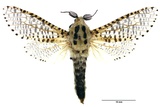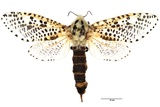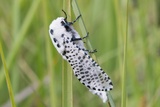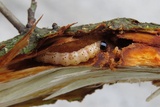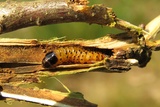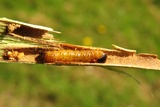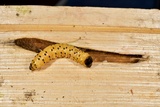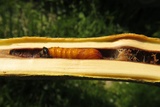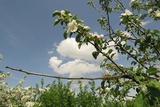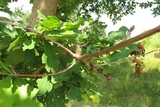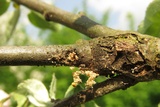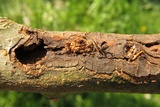Zeuzera pyrina (Linnaeus, 1761) Species
Last modified: Jan. 2, 2024, 5:03 p.m.
A common species throughout Belgium.
Details
- Classification
- Family: Cossidae > Subfamily: Zeuzerinae > Genus: Zeuzera > Species: Zeuzera pyrina
- Vernacular names
- Gestippelde houtvlinder (NL), Leopard Moth (EN), Zeuzère du poirier, Coquette, Zeuzère du marronnier (FR), Blausieb (DE)
- Synonyms
- Zeuzera aesculi (Linnaeus, 1767)
- First mention in Belgium
- De Sélys-Longchamps E. 1837. Catalogue des Lépidoptères ou Papillons de la Belgique, précédé du tableau des Libellulines de ce pays. — — : 1–29. On page 24 (as Zeuzera AEsculi). view page
- Status
-
Native
Distribution
Egg
The eggs are deposited individually or in small groups on the bark.
Bionomics
The caterpillar lives in hardwood, usually in very thin branches. The larva hibernates twice. It feeds in the living wood (branches, trunks) of the host plant, usually thin young trunks or branches with a diameter of no more than 10 cm.
Frass often indicates the larval presence. Infected thin branches sometimes wilt and die.
The full grown larva prepares an exit hole which sometimes remains closed by a thin layer of bark.
Pupation takes place at the end of the gallery, head down. The pupa protrudes the exit hole before emerging.
The moths come to light but males more frequently than females.
Flight periods
The adults fly from the end of May till the end of August but very occasionally also till late September. Most observations during June/July.
Observed on
- Substrates:
- Deciduous trees and Shrubs
Various deciduous trees and shrubs, often in fruit trees. To name a few Populus, Salix, Fagus sylvatica, Quercus robur, Carpinus betulus, Corylus avellana, Pyrus communus, Malus domesticus, Sorbus aucuparia, Prunus, Crataegus, Cydonia oblonga, Spirea, Rubus idaeus, Acer, Aesculus hippocastanum, Ilex aquifolium, Tilia, Frangula alnus, Olea europaea, Fraxinus excelsior, Syringa vulgaris, Viburnum lantana, Hippophae rhamnoides, Ulmus, Ribes, Lonicera, Rhus typhina, Mahonia, Tamarix, Platanus, Vitis vinifera etc...
Habitat
It inhabits wooded areas.
